| Pages:
1
..
33
34
35
36
37
..
68 |
Oscilllator
National Hazard
   
Posts: 659
Registered: 8-10-2012
Location: The aqueous layer
Member Is Offline
Mood: No Mood
|
|
Quote: Originally posted by Manifest  | Aluminium is easy enough to melt, there are many videos on youtube with people melting it using make-shift furnaces.
I'm thinking it would be easy enough to make a aluminium cone.
I am not sure how you could make the mold of it. |
You can get countersink drills of diameter of about 40mm, and I imagine if you drill a hole into a suitable mold material (wood may even work
considering the short timescales I have in mind) then you could pour a blob of molten aluminium into the conical depression, then push a cone into
that depression, forcing the molten aluminium into a cone shape in a manner similar to a wax seal.
Having said that though, Aluminium is not a very good material to make a liner because of its low density.
|
|
|
Bert
Super Administrator
        
Posts: 2821
Registered: 12-3-2004
Member Is Offline
Mood: " I think we are all going to die. I think that love is an illusion. We are flawed, my darling".
|
|
Microwave kiln, scrap electrical wire for Copper and casting via Lost wax is possible with some skill.
http://microfoundry.storenvy.com/products/1270377-microfound...
There are several presentations on making one's own microwave kiln online.
But spinning Copper might be easier & quicker-
Rapopart’s Rules for critical commentary:
1. Attempt to re-express your target’s position so clearly, vividly and fairly that your target says: “Thanks, I wish I’d thought of putting it
that way.”
2. List any points of agreement (especially if they are not matters of general or widespread agreement).
3. Mention anything you have learned from your target.
4. Only then are you permitted to say so much as a word of rebuttal or criticism.
Anatol Rapoport was a Russian-born American mathematical psychologist (1911-2007).
|
|
|
careysub
International Hazard
    
Posts: 1339
Registered: 4-8-2014
Location: Coastal Sage Scrub Biome
Member Is Offline
Mood: Lowest quantum state
|
|
That's not the only reason - aluminum has a tendency to react energetically with the explosive gases and burn up (that's why so many explosive
compositions have "aluminized" versions).
|
|
|
Energetic Einstein
Harmless

Posts: 12
Registered: 10-1-2014
Member Is Offline
Mood: No Mood
|
|
Quote: Originally posted by careysub  |
That's not the only reason - aluminum has a tendency to react energetically with the explosive gases and burn up (that's why so many explosive
compositions have "aluminized" versions). |
Are you assuming all of the aluminum liner is going to react upon detonation, or just that a thin layer of the aluminum will? Densities of metal
liners can vary based on what material you are planning to penetrate.
|
|
|
careysub
International Hazard
    
Posts: 1339
Registered: 4-8-2014
Location: Coastal Sage Scrub Biome
Member Is Offline
Mood: Lowest quantum state
|
|
Quote: Originally posted by Energetic Einstein  | Quote: Originally posted by careysub  |
That's not the only reason - aluminum has a tendency to react energetically with the explosive gases and burn up (that's why so many explosive
compositions have "aluminized" versions). |
Are you assuming all of the aluminum liner is going to react upon detonation, or just that a thin layer of the aluminum will? |
Some portion of the liner seems to react with the combustion gases, and some portion may actually react with the target (if penetrating concrete,
stone or soil).
Liners made of copper, and other typical dense materials produced deep narrow penetration holes, and are very well modeled by hydrodynamic numerical
simulation.
Aluminum liners produce wider, shallower holes in concrete (they penetrate steel very poorly) and when compared to straight hydrodynamic simulations
they show "non-ideal" behavior.
Instead of acting as a pure long-rod penetrator like traditional shaped charges they seem to create a local blast effect at the expense of penetration
depth.
| Quote: | | Densities of metal liners can vary based on what material you are planning to penetrate. |
This is indeed the case.
Aluminum reactivity may actually be desirable for low density targets like concrete (it might actually be reacting with the concrete also), depending
on the effect you want to achieve.
There has been work done on creating even more reactive liners (lithium-aluminum alloys for example).
[Edited on 26-8-2014 by careysub]
|
|
|
Energetic Einstein
Harmless

Posts: 12
Registered: 10-1-2014
Member Is Offline
Mood: No Mood
|
|
Interesting. So "Newtons Penetration Approximation" would be be useful when it comes to designing a liner?
I have never heard of a reactive liner before. What would be the be the use for it?
|
|
|
careysub
International Hazard
    
Posts: 1339
Registered: 4-8-2014
Location: Coastal Sage Scrub Biome
Member Is Offline
Mood: Lowest quantum state
|
|
Yes.
What you may read about shaped charges "burning holes", or that it sends in a jet of vaporized metal (even claims of it being a "plasma") are
nonsense. The liner flows under the extreme pressure, but is solid. If it stretches too much (too much stand-off) it breaks up into particles and the
penetration is much reduced.
| Quote: | | I have never heard of a reactive liner before. What would be the be the use for it? |
They are a specialized thing, and I am not sure how much use they have actually seen.
Blowing bigger holes in concrete (as part of a dual warhead, perhaps) or in a rock face before setting a blasting charge.
There is overlap between shaped charges, explosively formed penetrators (the archetype is the Misznay-Schardin effect), and directed blast warheads; a
charge can partake of more than one of these in its effect.
[Edited on 27-8-2014 by careysub]
|
|
|
Laboratory of Liptakov
International Hazard
    
Posts: 1387
Registered: 2-9-2014
Location: Technion Haifa
Member Is Offline
Mood: old jew
|
|
Kumula
Needless to invent an aluminum insert. Needless to test copper plating. Needless to produce glass exploding shrapnel. Producing a steel mandrel with
an angle of 84 degrees. A 0.55 mm Cu sheet strength. Or 1 mm. Hammer. Wooden chopping block. Steel rectangle. Propane-butane torch. The annealing.
Production takes 10 minutes. No lathe. The pictorial compilation hopefully everyone will understand. Loaded: Cyklonan III. 25 grams. Density 1.2 g /
cc. Bar diameter 26 mm. Distanc 39 mm. Steel 20 mm.
LL
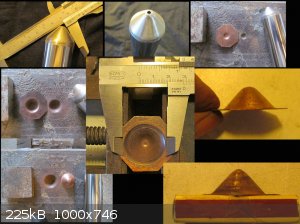
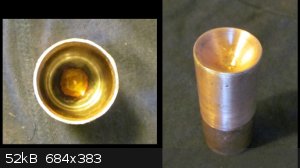
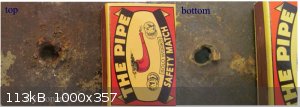
|
|
|
Laboratory of Liptakov
International Hazard
    
Posts: 1387
Registered: 2-9-2014
Location: Technion Haifa
Member Is Offline
Mood: old jew
|
|
Yet he adds. A good combination would be: Base plate of 0.55 mm to produce the instructions here. And then called 'thinning Cu. On the strength of
1mm. The electrostatic field is applied a thicker layer on the top hat. This is needed. There is always the weakest plate. A risk of rupture. In this
paper: posted on 23-2-2014 at 2:07 from Neon is the good work. But the hat is very rough. When an acidic solution of copper electroplating for copper
is used a special additive. That will do it perfectly shiny hat. Like a mirror. Straight from the acid bath. His name is Novostar R1. It is added in
an amount of about 0.1%. My secret composition, it can not produce. They must buy. But the results are absolutely perfect. Mirror smooth and clean
surface.
LL
|
|
|
Energetic Einstein
Harmless

Posts: 12
Registered: 10-1-2014
Member Is Offline
Mood: No Mood
|
|
How did you produce a mandrel that has an even 84 degrees? I assume you heated the copper plate with the propane torch then hammered the plate into a
cone? What was the steel rectangle used for?
|
|
|
markx
National Hazard
   
Posts: 646
Registered: 7-8-2003
Location: Northern kingdom
Member Is Offline
Mood: Very Jolly
|
|
I tried some of the nice Bachmann cyclonite as a shaped charge:
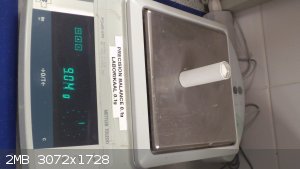 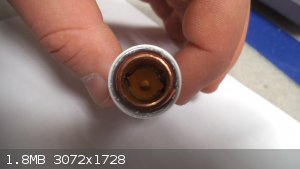 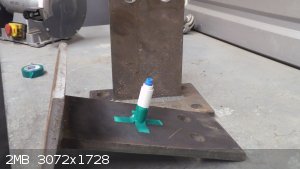 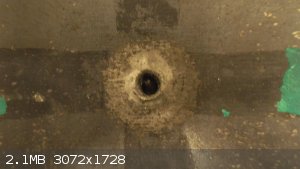
Substrate is 30mm construction steel (we got greedy and added 2 plates under the charge). That was an obvious mistake, as the second plate effectively
relaxed the impulse and stopped the jet. So instead of a nice penetration of 15mm steel we got a carrot stuck in the crater.
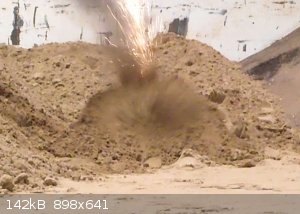 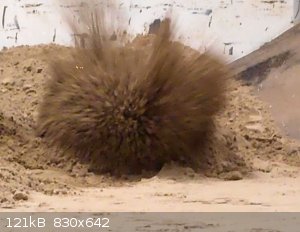 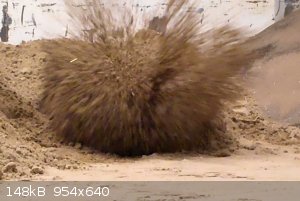 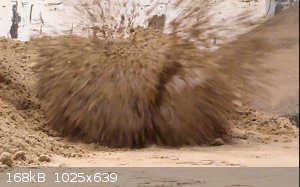 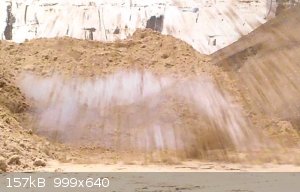
Exact science is a figment of imagination.......
|
|
|
Laboratory of Liptakov
International Hazard
    
Posts: 1387
Registered: 2-9-2014
Location: Technion Haifa
Member Is Offline
Mood: old jew
|
|
work
Perfect work. Cyclonit is much stronger than Cyklonane. Course. Beautiful photos. Detonation seqence. Better of fireworks...... I appreciate handmade. Good handwork? Good documentation? That is always a little.
Many speech? Without documentation? That is always very much. I appreciate handmade. Good handwork? Good documentation? That is always a little.
Many speech? Without documentation? That is always very much.
LL
[Edited on 25-9-2014 by Laboratory of Liptakov]
|
|
|
NeonPulse
Hazard to Others
  
Posts: 417
Registered: 29-6-2013
Location: The other end of the internet.
Member Is Offline
Mood: Isolated from Reality! For Real this time....
|
|
Quote: Originally posted by Laboratory of Liptakov  | Perfect work. Cyclonit is much stronger than Cyklonane. Course. Beautiful photos. Detonation seqence. Better of fireworks...... I appreciate handmade. Good handwork? Good documentation? That is always a little.
Many speech? Without documentation? That is always very much. I appreciate handmade. Good handwork? Good documentation? That is always a little.
Many speech? Without documentation? That is always very much.
LL
[Edited on 25-9-2014 by Laboratory of Liptakov] |
I think you need a better translator. Some of your posts are pretty hard to understand.
|
|
|
Bert
Super Administrator
        
Posts: 2821
Registered: 12-3-2004
Member Is Offline
Mood: " I think we are all going to die. I think that love is an illusion. We are flawed, my darling".
|
|
One thing to consider when posting images of a charges effect on plates, etc.-
Put an object to show scale next to the crater. Ruler, meter stick, even a common coin.
As you observed, layered or discontinuous target plates can disrupt a jet... Just start out with a thicker piece of steel if you have access.
Rapopart’s Rules for critical commentary:
1. Attempt to re-express your target’s position so clearly, vividly and fairly that your target says: “Thanks, I wish I’d thought of putting it
that way.”
2. List any points of agreement (especially if they are not matters of general or widespread agreement).
3. Mention anything you have learned from your target.
4. Only then are you permitted to say so much as a word of rebuttal or criticism.
Anatol Rapoport was a Russian-born American mathematical psychologist (1911-2007).
|
|
|
NeonPulse
Hazard to Others
  
Posts: 417
Registered: 29-6-2013
Location: The other end of the internet.
Member Is Offline
Mood: Isolated from Reality! For Real this time....
|
|
How much jet disruption would occur if the plates were complety flush and smooth between them? I know the best representation is into a solid target
but I would like to do an experiment on stacked plates to see the jet path through each individual plate and take a very close at them look with a
microscope.
I'm not sure what I'd be looking for but it would be interesting, particularly where the jet tip stops. Perhaps examine the steel grain in comparison
to un-stressed metal. That is if I can stack enough of them to stop full penetration. It would make a neat experiment and with more purpose than just
punching holes through steel hammer heads.
|
|
|
markx
National Hazard
   
Posts: 646
Registered: 7-8-2003
Location: Northern kingdom
Member Is Offline
Mood: Very Jolly
|
|
Only a test with stacked plates will show the real results, but from what I saw in my endeavour, the second plate stopped the jet dead still at the
verge of the interface. The second plate was dented just like a blob of plastique had been detonated on top of it , but there was not the slightest of
jet transition into it. The carrot was stuck in the crater also at the interface layer....one could basically see it from the other side of the plate,
so thin was the metal left around the possible penetration area.
For comparison, here is a snapshot of 30mm uniform steel plate suffering from a 8,3g PETN shaped charge set off on top:
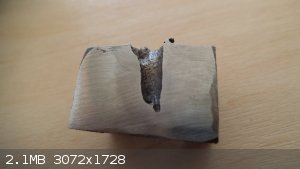
Unfortunately no scale reference again....oh well
The construction, placement and initiation of the charge were identical to the one portrayed in cyclonite test above. In this case there was no sign
of the carrot anywhere to be found...I guess it disintegrated or was joined completely with the crater surface.
Sometimes there are very interesting and peculiar branching phenomenons of the jet that curve into the target off the main flow or move basically
perpendicular to the main jet direction. Also in this shot one can see such effects on the top of the crater and also in the bottom part. Truly
facinating subject...
[Edited on 29-9-2014 by markx]
Exact science is a figment of imagination.......
|
|
|
Laboratory of Liptakov
International Hazard
    
Posts: 1387
Registered: 2-9-2014
Location: Technion Haifa
Member Is Offline
Mood: old jew
|
|
EFP
It is the exact shape of the copper pads? If yes, does the hole inaccurate and causes material. It's like magic. Liquid copper drills (evaporate)
steel. Again, a perfect piece of work. Markx: I see you have a lot of experience and you can make anything. Have you tried EFP? The basic proposal
here. Diameter 68 mm = 2 mm copper..........
LL
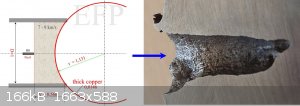
[Edited on 29-9-2014 by Laboratory of Liptakov]
|
|
|
markx
National Hazard
   
Posts: 646
Registered: 7-8-2003
Location: Northern kingdom
Member Is Offline
Mood: Very Jolly
|
|
Quote: Originally posted by Laboratory of Liptakov  | It is the exact shape of the copper pads? If yes, does the hole inaccurate and causes material. It's like magic. Liquid copper drills (evaporate)
steel. Again, a perfect piece of work. Markx: I see you have a lot of experience and you can make anything. Have you tried EFP? The basic proposal
here. Diameter 68 mm = 2 mm copper..........
LL
[Edited on 29-9-2014 by Laboratory of Liptakov] |
I must admit that I have been contemplating an efp design for a long time, but not yet gotten around to it. Seemed much more challenging to attempt a
cumulative jet forming device at first. Guess I can try a shot at efp too...just maybe not to the scale that you propose. I'm afraid it poses a more
serious challenge to silence the scream of that device than the actual construstion of it. A cumulative device I can shoot under the sand and silence
it thus to an acceptable level. Burying an efp setup will take more commitment though.
Exact science is a figment of imagination.......
|
|
|
Laboratory of Liptakov
International Hazard
    
Posts: 1387
Registered: 2-9-2014
Location: Technion Haifa
Member Is Offline
Mood: old jew
|
|
EFP 2 inch
You have the same thoughts as me. A similar reasons. Therefore, even in LL EFP was not tested. It is technically very challenging project. The maximum
diameter plates for tests I see is 50mm. This is the weight load from 60 to 100 grams. About 0.73 mm thick Cu. On your test track as possible. I know
this is an expensive test. But: 50mm = penetration (up to) 25 mm steel. Large hole! It has all to see! .................

|
|
|
ecos
Hazard to Others
  
Posts: 464
Registered: 6-3-2014
Member Is Offline
Mood: Learning !
|
|
Hi All,
This link has some nice resources if someone is interested : Link
|
|
|
Laboratory of Liptakov
International Hazard
    
Posts: 1387
Registered: 2-9-2014
Location: Technion Haifa
Member Is Offline
Mood: old jew
|
|
copper cone
This is a good read. Technology of production of copper cone. (from the list)
Liners for Shaped Charges by Manfred Held (2001).pdf
LL
|
|
|
Laboratory of Liptakov
International Hazard
    
Posts: 1387
Registered: 2-9-2014
Location: Technion Haifa
Member Is Offline
Mood: old jew
|
|
Sergeant James
I got a message from Sergeant James. It's a really tough guy... ...LL ...LL

|
|
|
Hennig Brand
International Hazard
    
Posts: 1284
Registered: 7-6-2009
Member Is Offline
Mood: No Mood
|
|
Explosively Formed Penetrator (EFP); Misznay–Schardin Effect
I started experimenting with explosively formed penetrators a little bit. Below are a few pictures of my first, and only, test so far. Thanks go to
Markx for the idea of using coins to make the platters. In this test a Canadian dime was used. The coin was pressed into the curved shape (dish) using
a ball peen hammer, a nut the appropriate size and a vise to apply force. The charge casing was made from a section of cardboard tube from a spent
consumer fireworks aerial shell mortar tube, which happened to be the right size for the curved dime. The charge used was 8.5g of a putty explosive
composed of, 81% ETN and 19% inerts, which was initiated with a 5mm id aluminum cap containing 0.5g of PETN and 0.15g LA. The target was 3/8" steel.
The stand-off was arbitrarily set at 10cm.
Charge Casing:
D = ~1.8 cm id, ~2.4 cm od
L = ~3 cm
I think I was a little over enthusiastic when I chose to use 3/8" steel over 1/4" steel as the target. It didn't penetrate the 3/8" target, but it
looked like it would have if the plate had been only 1/4". There was a large welt on the back of the plate. The width of the hole in the witness plate
indicates low slug velocity and a short wide slug with low penetration. Higher velocities would cause the slug to elongate more and produce more
penetration. According to Wiki, (referring to improvised devices I believe) "As a rule of thumb, an EFP can perforate a thickness of armour steel
equal to half the diameter of its charge for a copper or iron liner, and armour steel equal to the diameter of its charge for a tantalum liner,
whereas a typical shaped charge will go through six or more diameters."
The target was a bit more than half the thickness of the charge used and I am sure many things were not optimized. I will try it again possibly with a
higher velocity explosive or with a 1/4" steel target.
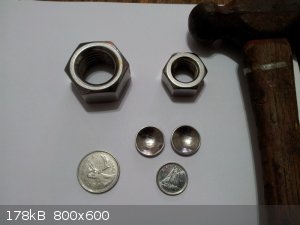
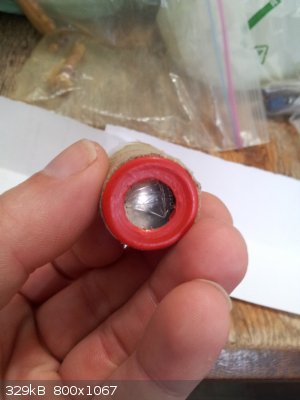 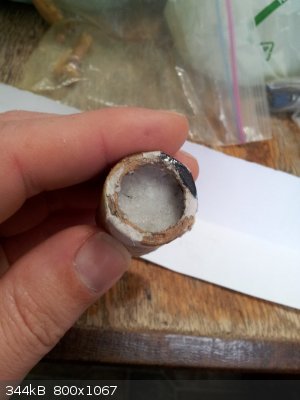 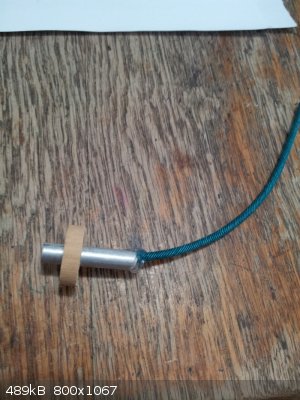 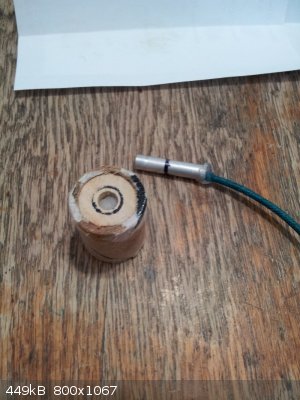 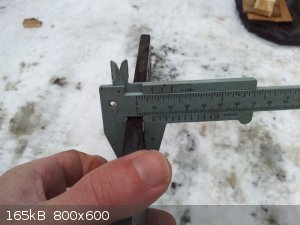
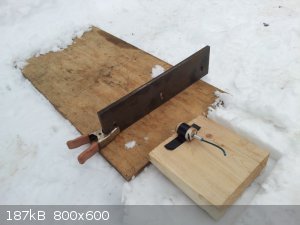 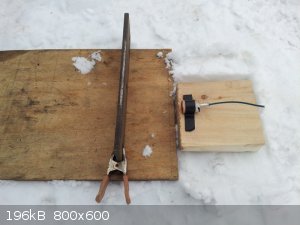 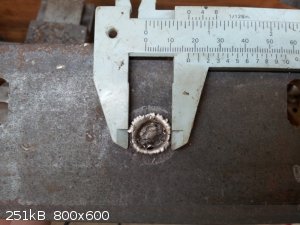 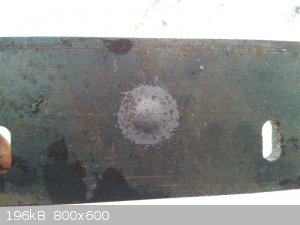
[Edited on 26-12-2014 by Hennig Brand]
"A risk-free world is a very dull world, one from which we are apt to learn little of consequence." -Geerat Vermeij
|
|
|
VladimirLem
Hazard to Others
  
Posts: 204
Registered: 24-5-2010
Member Is Offline
Mood: Have no fear <Vlad> is here.
|
|
Pretty cool test you did, Hennig
I think the standoff is very important at EFPs too (like SCs)...
Maybe you give it a try with 50cm< standoff at the same CD?
|
|
|
Laboratory of Liptakov
International Hazard
    
Posts: 1387
Registered: 2-9-2014
Location: Technion Haifa
Member Is Offline
Mood: old jew
|
|
perfect
Again a very good job Hennig. The best I've ever seen. Vladimir writes important thing. 10 cm distance is too small. I studied patents. Projektyl is
not enough to shape. It must be at least 40 cm. Top 50cm. (for this diameter). I see significant deformation of steel 10 mm. This is the beginning of
a very good result. In such a small scale are materials (steel) strength. A lower efficiency in explosives. It is due to finite size of an atom. I'll
try to explain it differently: 1) For airplanes (1 km height) throw ant (5mm). He lands on the grass. Nothing will happen. 2) For airplanes (1km)
throw a giant ant chitin (1500 mm). It certainly will be broken up into pieces. It is due to finite size of an atom. It is due to the number of atomic
bonds at the object. I hope you understand me ... ...LL ...LL
|
|
|
| Pages:
1
..
33
34
35
36
37
..
68 |